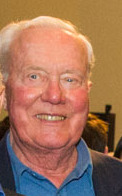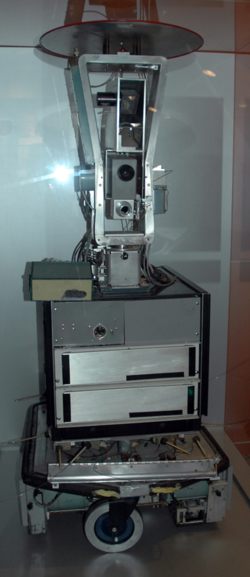Biography:Nils John Nilsson
Nils John Nilsson | |
|---|---|
 Nilsson in 2017 | |
| Born | February 6, 1933 Saginaw, Michigan, U.S. |
| Died | April 23, 2019 (aged 86) Medford, Oregon, U.S. |
| Nationality | American |
| Alma mater | Stanford University |
| Scientific career | |
| Fields | Artificial intelligence |
| Institutions | SRI International Stanford University |
| Doctoral advisor | Willis Harman[1] |
| Doctoral students | Leslie P. Kaelbling[1] |
Nils John Nilsson (February 6, 1933 – April 23, 2019) was an American computer scientist. He was one of the founding researchers in the discipline of artificial intelligence.[2] He was the first Kumagai Professor of Engineering in computer science at Stanford University from 1991 until his retirement. He is particularly known for his contributions to search, planning, knowledge representation, and robotics.[2]
Early life and education
Nilsson was born in Saginaw, Michigan, in 1933.[2] He received his Ph.D. from Stanford in 1958, and spent much of his career at SRI International, a private research lab spun off from Stanford.[2][3]
Nilsson served as a lieutenant in the United States Air Force from 1958 to 1961; he was stationed at the Rome Air Development Center in Rome, New York.[2][3]
Career
SRI International
Starting in 1966, Nilsson, along with Charles A. Rosen and Bertram Raphael, led a research team in the construction of Shakey, a robot that constructed a model of its environment from sensor data, reasoned about that environment to arrive at a plan of action, then carried that plan out by sending commands to its motors.[2][3] This paradigm has been enormously influential in AI.[2][3] Textbooks such as Introduction to Artificial Intelligence,[4] Essentials of Artificial Intelligence,[5] and the first edition of Artificial Intelligence: A Modern Approach[6] show this influence in almost every chapter.[2][3] Although the basic idea of using logical reasoning to decide on actions is due to John McCarthy,[7] Nilsson's group was the first to embody it in a complete agent, along the way inventing the A* search algorithm[8] and founding the field of automated temporal planning.[2][3] In the latter pursuit, they invented the STRIPS planner,[9] whose action representation is still the basis of many of today's planning algorithms. The subfield of automated temporal planning called classical planning is based on most of the assumptions built into STRIPS.[2][3]
Stanford University
In 1985, Nilsson became a faculty member at Stanford University, in the Computer Science Department.[3] He was chair of the department from 1985 to 1990.[3] He was the Kumagai Professor of Engineering from the foundation of the Chair in around 1991[10] until his retirement, and remained Kumagai Professor Emeritus until his death.[3]
He was the fourth President of the AAAI (1982–83) and a Founding Fellow of that organization.[3] Nilsson wrote or coauthored several books on AI, including two that have been especially widely read - Principles of Artificial Intelligence (1982) and Logical Foundations of Artificial Intelligence (1987).[2][3]
Awards and memberships
In 2011, Nilsson was inducted into IEEE Intelligent Systems' AI's Hall of Fame for the "significant contributions to the field of AI and intelligent systems".[citation needed]
Personal life
On July 19, 1958, Nilsson married Karen Braucht, with whom he had two children.[2][3] Braucht died in 1991.[2] In 1992 he married Grace Abbott, who had four children from a previous marriage.[2]
Nilsson died on April 23, 2019, at his home in Medford, Oregon, at the age of 86.[2][3]
Selected publications
- Genesereth, Michael; Nilsson, Nils John (1987), Logical Foundations of Artificial Intelligence, Morgan Kaufmann, ISBN 978-1-493-30598-8.
See also
- Morgan Kaufmann Publishers
References
- ↑ 1.0 1.1 "Nils J. Nilsson". https://www.genealogy.math.ndsu.nodak.edu/id.php?id=70729.
- ↑ 2.00 2.01 2.02 2.03 2.04 2.05 2.06 2.07 2.08 2.09 2.10 2.11 2.12 2.13 2.14 Markoff, John (April 25, 2019). "Nils Nilsson, 86, dies; scientist helped robots find their way". The New York Times. https://www.nytimes.com/2019/04/25/obituaries/nils-nilssen-dead.html.
- ↑ 3.00 3.01 3.02 3.03 3.04 3.05 3.06 3.07 3.08 3.09 3.10 3.11 3.12 3.13 Myers, Andrew (April 24, 2019). "Nils Nilsson, pioneer in robotics and artificial intelligence, dies at 86". https://news.stanford.edu/2019/04/24/nils-nilsson-pioneer-robotics-artificial-intelligence-dies-86/.
- ↑ Charniak, Eugene (1985). Introduction to artificial intelligence. Drew V. McDermott. Reading, Mass.: Addison-Wesley. ISBN 0-201-11945-5. OCLC 11468509. https://www.worldcat.org/oclc/11468509.
- ↑ Ginsberg, Matthew L. (1993). Essentials of artificial intelligence. Matt Ginsberg. San Mateo Calif: M. Kaufmann. ISBN 1-55860-334-4. OCLC 612190271. https://www.worldcat.org/oclc/612190271.
- ↑ Russell, Stuart J. (1995). Artificial intelligence : a modern approach. Peter Norvig. Englewood Cliffs, N.J.: Prentice Hall. ISBN 0-13-103805-2. OCLC 31288015. https://www.worldcat.org/oclc/31288015.
- ↑ McCarthy, John (1958). "Programs with Common Sense". http://jmc.stanford.edu/articles/mcc59.html.
- ↑ Hart, Peter; Nilsson, Nils; Raphael, Bertram (1968). "A Formal Basis for the Heuristic Determination of Minimum Cost Paths". IEEE Transactions on Systems Science and Cybernetics 4 (2): 100–107. doi:10.1109/TSSC.1968.300136. ISSN 0536-1567. https://ieeexplore.ieee.org/document/4082128.
- ↑ Fikes, Richard E.; Nilsson, Nils J. (December 1971). "Strips: A new approach to the application of theorem proving to problem solving" (in en). Artificial Intelligence 2 (3–4): 189–208. doi:10.1016/0004-3702(71)90010-5. https://linkinghub.elsevier.com/retrieve/pii/0004370271900105.
- ↑ "Thoughts on Becoming the First Kumagai Professor of Engineering". Stanford University. 18 March 1991. https://ai.stanford.edu/~nilsson/OnlinePubs-Nils/General%20Essays/OtherEssays-Nils/kumagaispeech.pdf.
External links
- Nilsson's home page
- Nils John Nilsson at the Mathematics Genealogy Project
- Nils J. Nilsson at the AI Genealogy Project.
- Oral history interview with Nils J. Nilsson, Charles Babbage Institute, University of Minnesota, Minneapolis. Nilsson gives an overview of DARPA-sponsored AI research at SRI, including his own work in robotics (especially during the period 1966-1971), research on the Computer Based Consultant, and related research on natural language and speech understanding. He describes the significance and relationship of robotics to the larger field of AI, particularly the intellectual problems it addressed and the enabling technologies it helped develop.
 |


